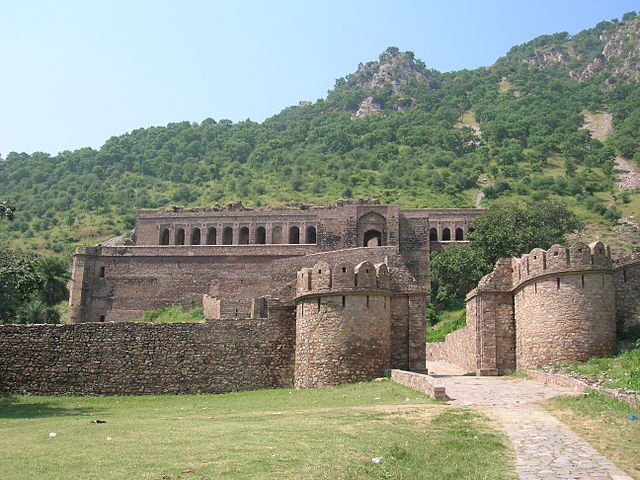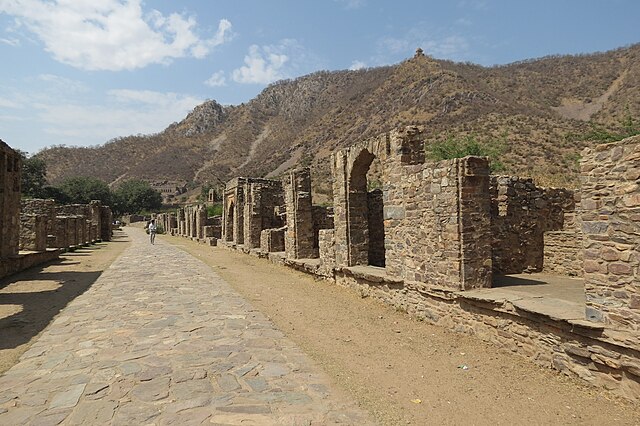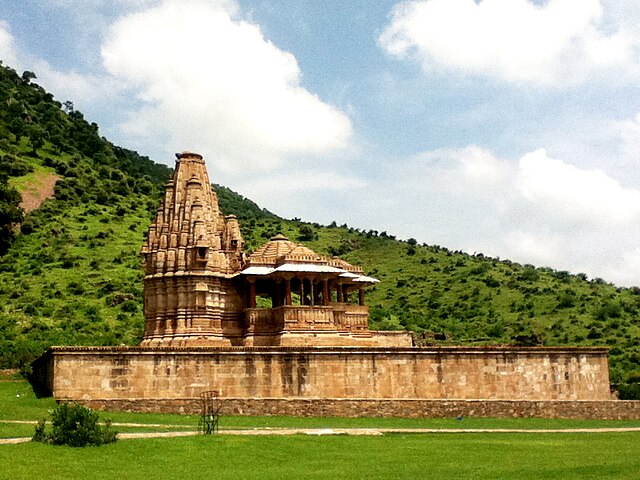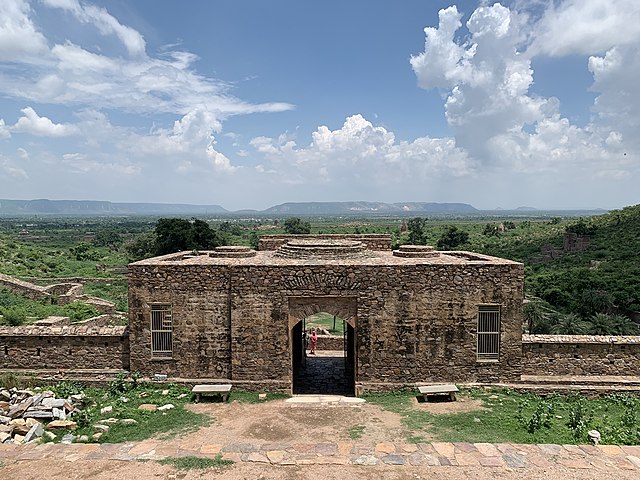What Makes Bhangarh Fort Special?
Have you ever wondered what it feels like to walk through a place where history and mystery intertwine so deeply that even the government officially acknowledges its supernatural reputation? Welcome to Bhangarh Fort, a 17th-century architectural marvel nestled in the Alwar district of Rajasthan that holds the unique distinction of being India’s only legally haunted place.
This isn’t just another tourist destination – it’s a place where the Archaeological Survey of India (ASI) has placed official restrictions on entry after sunset, making it the most intriguing historical site in the country. But what exactly makes this fort so special that it attracts thousands of visitors annually while simultaneously warning them to leave before dark?
Historical Significance of the 17th Century Ruins
Bhangarh Fort stands as a testament to the architectural brilliance of the Mughal era, built in 1573 by Raja Bhagwant Das of Amber. The fort complex spans across a vast area, showcasing a perfect blend of Rajput and Mughal architectural styles that were prevalent during the 16th and 17th centuries.
The fort served as a flourishing city with a population of over 10,000 residents at its peak. Merchants, artisans, and nobles called this place home, creating a vibrant community that thrived for centuries. The remnants of bazaars, residential areas, and administrative buildings still tell the story of a once-prosperous settlement that mysteriously declined and was eventually abandoned.
Archaeological Survey of India’s Official Haunted Status
What sets Bhangarh apart from other historical ruins is the ASI’s unprecedented decision to legally prohibit entry between sunset and sunrise. This official recognition of the fort’s supernatural reputation is unique in India’s archaeological landscape. The ASI board clearly states that entering the premises after sunset is legally prohibited, making it the only protected monument with such restrictions based on paranormal grounds.
This official stance isn’t taken lightly – it comes after decades of reported incidents, unexplained phenomena, and persistent local beliefs that have been passed down through generations.
The Dark History Behind Bhangarh Fort

Every haunted location has its origin story, and Bhangarh Fort’s tale is as captivating as it is chilling. The fort’s dark reputation isn’t just modern folklore – it’s deeply rooted in historical events and local legends that have been preserved for over 400 years.
Raja Bhagwant Das and the Foundation Story
The story begins with Raja Bhagwant Das, who was not just a ruler but also a devoted follower of spiritual practices. Before constructing the fort, he sought the blessings of a local sage named Baba Balanath, who lived in meditation on the hilltop where the fort was to be built.
The sage agreed to the construction with one crucial condition: the shadow of the fort’s buildings should never fall upon his meditation spot. This condition was religiously followed during the initial construction phases, and the fort prospered under this spiritual protection.
The most famous legend revolves around Princess Ratnavati, the beautiful daughter of Raja Bhagwant Das’s successor. Her beauty was renowned throughout the region, attracting suitors from far and wide. However, it also caught the attention of Singhia, a tantrik (practitioner of dark magic) who knew that winning her heart through conventional means was impossible.
The Tantrik’s Revenge Legend
Singhia decided to use black magic to make the princess fall in love with him. He cast a spell on perfume oil that the princess was about to purchase from the local market. However, Princess Ratnavati was wise to his intentions and threw the enchanted oil onto a large boulder.
The boulder, under the spell’s influence, began rolling toward Singhia and crushed him to death. As he lay dying, Singhia cursed the entire city, prophesying that it would be destroyed and remain uninhabited forever. According to legend, within a year of this curse, Bhangarh was attacked by the Mughals, and Princess Ratnavati died in the battle, along with most of the city’s population.
Alternative Historical Theories
While the curse makes for compelling storytelling, historians offer alternative explanations for Bhangarh’s abandonment. Some suggest that the decline was due to severe famine that struck the region in the 18th century. Others point to the constant invasions and political instability that made the area unsafe for habitation.
The economic theory suggests that trade routes shifted, making Bhangarh less commercially viable. Without commerce, the population gradually migrated to more prosperous areas, leaving the fort to decay naturally over time.
Architecture and Layout of Bhangarh Fort
Despite its haunted reputation, Bhangarh Fort remains an architectural marvel that showcases the sophisticated building techniques of the Mughal era. The fort complex is spread over a large area and includes multiple structures that served different purposes in the original city.
Palace Complex and Royal Chambers
The main palace structure sits at the heart of the fort, featuring intricate carvings and architectural details that reflect the wealth and power of its former inhabitants. The royal chambers are built with thick walls designed to provide protection as well as comfort in Rajasthan’s extreme climate.
The palace features multiple courtyards, each serving specific ceremonial or administrative functions. The durbar hall, where the king held court, still retains traces of its former grandeur with carved pillars and decorated walls that hint at the opulence that once graced these halls.
Temple Structures Within the Fort
What makes Bhangarh unique among fort complexes is the integration of religious structures within the defensive walls. Several temples were built as part of the original design, serving the spiritual needs of the fort’s residents.
Hanuman Temple – The Still-Active Shrine
Interestingly, among all the structures in Bhangarh, the Hanuman Temple remains active and is regularly visited by devotees. Local belief holds that Hanuman’s presence protects visitors during daylight hours, which is why the temple continues to receive offerings and prayers.
This active temple serves as a spiritual anchor in an otherwise abandoned complex, and many visitors report feeling a sense of protection and peace when near this shrine, contrasting sharply with the eerie atmosphere of other areas.
Paranormal Activities and Ghost Stories
The supernatural reputation of Bhangarh Fort isn’t based solely on ancient legends – it’s supported by numerous modern accounts from visitors, security guards, and local residents who have experienced unexplained phenomena.
Documented Supernatural Encounters
Visitors have reported a wide range of paranormal experiences, from hearing unexplained sounds like footsteps, whispers, and music coming from empty buildings to seeing shadowy figures moving through the ruins. Security guards posted at the site have reported feeling an oppressive atmosphere after dark, with some refusing to patrol certain areas of the fort.
Photography enthusiasts have captured unexplained anomalies in their pictures, including orbs of light, shadowy figures, and strange mists that appear in photographs but weren’t visible to the naked eye at the time of shooting.
Why Entry is Prohibited After Sunset
The ASI’s decision to prohibit entry after sunset wasn’t made arbitrarily. It came after years of reported incidents involving visitors who either went missing or were found in distressed conditions after spending time in the fort after dark. While skeptics argue that the restrictions are primarily for safety reasons due to the rugged terrain and wildlife, the official haunted status suggests there’s more to the story.
Local authorities report that people who have attempted to stay in the fort overnight have been found in various states of distress, though specific details are often kept confidential to avoid sensationalizing the incidents.
Complete Travel Guide to Bhangarh Fort

Planning a visit to Bhangarh Fort requires more than just deciding on a date – you need to understand the logistics, restrictions, and best practices to make your trip both safe and memorable.
Best Time to Visit Bhangarh Fort
The ideal time to visit Bhangarh Fort is during the cooler months from October to March, when Rajasthan’s weather is more pleasant for exploring outdoor historical sites. During these months, daytime temperatures are comfortable, making it easier to spend several hours exploring the extensive fort complex.
Avoid visiting during the summer months (April to June) when temperatures can soar above 45°C, making outdoor exploration extremely uncomfortable and potentially dangerous. The monsoon season (July to September) can make the terrain slippery and some areas inaccessible.
How to Reach Bhangarh from Major Cities
Bhangarh Fort’s location in Alwar district makes it accessible from several major cities in northern India, though the journey requires some planning as the fort is not directly connected to major transportation hubs.
From Delhi and Jaipur
From Delhi, the most convenient route is to drive or take a bus to Alwar city, which is approximately 200 kilometers away. From Alwar, Bhangarh is another 83 kilometers, requiring local transportation or a private vehicle.
From Jaipur, the distance is shorter at about 85 kilometers to Alwar, making it a popular day trip destination for visitors staying in the Pink City. Many tour operators offer day trips from Jaipur that include Bhangarh Fort along with other nearby attractions.
Local Transportation Options
Once you reach Alwar, you can hire a taxi, use ride-sharing services, or take a local bus to reach Bhangarh. Private taxis are the most convenient option as they allow you to explore at your own pace and visit nearby attractions on the same trip.
Local buses are available but operate on limited schedules, so it’s important to check timing in advance to ensure you don’t get stranded at the fort.
Entry Fees, Timings, and Visitor Guidelines
Understanding the official rules and regulations is crucial for a smooth visit to Bhangarh Fort, as the site has specific restrictions that are strictly enforced.
Official ASI Rules and Regulations
The Archaeological Survey of India charges a nominal entry fee for Indian citizens and a higher fee for foreign tourists, similar to other protected monuments. However, unlike other historical sites, Bhangarh has strict timing restrictions that must be observed.
Entry is permitted only between sunrise and sunset, with the exact timings varying by season. Security guards strictly enforce these timings, and no exceptions are made for visitors who wish to experience the fort’s “haunted” atmosphere after dark.
Photography is generally permitted for personal use, but commercial photography requires special permission from ASI. Drone photography is strictly prohibited without prior authorization.
What to Expect During Your Visit
A visit to Bhangarh Fort is unlike exploring other historical sites – the atmosphere is distinctly different, and visitors often report feeling the weight of the place’s history and legends.
Photography Tips and Restrictions
While photography is allowed, many visitors report technical difficulties with their cameras and phones while at the fort. Batteries drain faster than usual, and some electronic devices malfunction temporarily. It’s advisable to carry backup batteries and memory cards.
The best photographic opportunities are during the golden hour, just after sunrise or before sunset, when the lighting creates dramatic shadows and highlights the architectural details beautifully.
Nearby Attractions and Day Trip Options

Bhangarh Fort can easily be combined with other attractions in the Alwar district to create a full day of exploration. The Sariska Tiger Reserve is approximately 24 kilometers away and offers wildlife viewing opportunities.
The ancient Neelkanth Temple, dedicated to Lord Shiva, is located within walking distance of the fort and provides a spiritual contrast to Bhangarh’s eerie atmosphere. The temple is still active and offers a peaceful respite during your visit.
Safety Tips for Visiting Bhangarh Fort
Safety should be your top priority when visiting Bhangarh Fort, not just because of its supernatural reputation, but due to practical considerations as well.
Always visit in groups and inform someone of your travel plans. The fort complex is extensive with many partially ruined structures, so watch your step to avoid injury from loose stones or uneven surfaces.
Carry sufficient water and snacks, as facilities near the fort are limited. Wear comfortable walking shoes with good grip, as you’ll be walking on uneven ancient stone surfaces.
Most importantly, respect the sunset restriction. Attempting to stay after dark is not only illegal but potentially dangerous due to the terrain and wildlife in the area.
Debunking Myths vs Reality
While Bhangarh Fort’s haunted reputation is fascinating, it’s important to separate fact from fiction when planning your visit. The fort is indeed atmospheric and carries a heavy sense of history, but many of the more sensational stories have been embellished over time.
The restriction on nighttime entry is likely a combination of safety concerns, wildlife protection, and respect for local beliefs rather than just supernatural considerations. The fort’s isolated location and ruined state make it genuinely hazardous to navigate in darkness.
However, the consistent reports of unusual experiences from diverse groups of visitors suggest that there may be more to Bhangarh than conventional explanations can account for, making it a genuinely intriguing destination for those interested in history, architecture, and the unexplained.
Conclusion
Bhangarh Fort represents a unique intersection of history, architecture, and mystery that makes it one of India’s most fascinating destinations. Whether you’re drawn by its architectural significance, historical importance, or supernatural reputation, the fort offers an experience unlike any other historical site in the country.
The key to enjoying your visit is approaching it with respect for both its historical significance and the beliefs surrounding it. Come prepared, follow the rules, and allow yourself to be transported back to a time when this now-silent complex was a thriving city full of life and activity.
Remember that beyond the ghost stories and legends, Bhangarh Fort is a valuable piece of India’s architectural heritage that deserves preservation and respect. Your visit contributes to its conservation while giving you the chance to experience one of the country’s most enigmatic historical sites.
Frequently Asked Questions (FAQs)
1. Is it really dangerous to visit Bhangarh Fort after sunset?
While no official incidents have been publicly documented, the ASI’s strict prohibition on nighttime entry is based on a combination of safety concerns and respect for local beliefs. The terrain becomes hazardous in darkness, and wildlife activity increases, making nighttime visits genuinely risky regardless of supernatural considerations.
2. Can I take photographs inside Bhangarh Fort?
Yes, personal photography is allowed throughout the fort complex. However, many visitors report technical issues with their cameras and phones, including faster battery drain and temporary malfunctions. Commercial photography requires special permission from the Archaeological Survey of India.
3. How much time should I allocate for visiting Bhangarh Fort?
A thorough exploration of the fort complex typically takes 3-4 hours. This allows time to visit all the major structures, take photographs, and absorb the atmosphere. If you’re combining it with nearby attractions like Sariska Tiger Reserve, plan for a full day trip.
4. Are there any facilities available at Bhangarh Fort?
Basic facilities like parking and restrooms are available, but amenities are minimal. There are small shops selling snacks and water near the entrance, but it’s advisable to carry your own supplies. The nearest proper restaurants and accommodation are in Alwar city.
5. What’s the best way to reach Bhangarh Fort if I don’t have a private vehicle?
The most convenient option is to hire a taxi from Alwar city, which is well-connected to major cities by train and bus. Many tour operators in Jaipur and Delhi offer day trips that include transportation. Local buses are available but operate on limited schedules, so check timings in advance.

